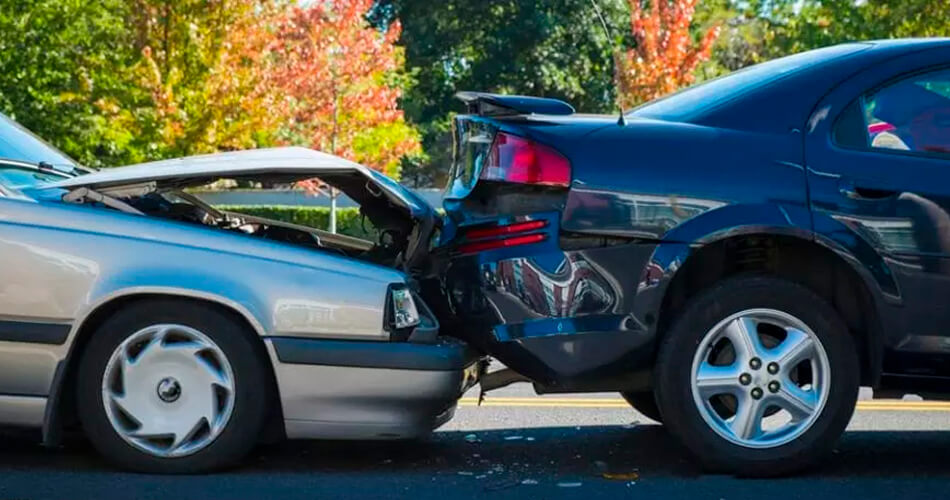Did you know that rear-end collisions are the most common type of car accident in the United States? According to the National Highway Traffic Safety Administration, rear-end collisions make up nearly 30 percent of collisions nationwide, or about 1.7 million accidents each year.
Contents
Over 80 percent rear-end collisions happen when the lead vehicle is completely stopped or moving at a very slow speed, usually as the result of a driver following the car in front of them too closely. Unfortunately, even minor “fender-benders” can cause hidden damage in addition to cosmetic damage like dents or scratches.
What is Hidden Damage?
Hidden damage is damage to the frame, mechanics, or electrical systems within a vehicle that may not be visible or immediately apparent following an accident. Here are the most common types of hidden damage caused by rear-end collisions:
Damage to the Vehicle Frame
Think of a vehicle frame as the skeleton of your car. A fender-bender can throw the vehicle frame out of alignment, just like it can to your own back or neck. If your car’s frame has been damaged, it can cause a litany of issues:
Alignment problems
One of the most common issues after your vehicle’s frame has been damaged is alignment problems. Here are some common symptoms of vehicle alignment problems:
- The steering wheel seems to gravitate one direction;
- The steering wheel is shaky or wobbly;
- Noisy steering;
- Tires are showing uneven wear;
- The vehicle vibrates or shudders.
Even slight misalignments can put unnecessary stress on other parts of the vehicle and exacerbate the damage.
Trunk, hood, and door damage
When your car’s frame has been damaged, it can impact latch mechanisms and seals on your trunk, hood, and doors. If a trunk, hood or door latch is broken it can cause them to pop open unexpectedly, even while driving. Damage to the seal around a door or trunk can allow moisture to get in, which can eventually cause rust around the car frame, or even mold and mildew in the interior. After an accident, test all of the latches for the trunk, hood, and doors to make sure they latch properly.
Suspension issues
A damaged vehicle frame can cause extra wear and tear on the vehicle’s suspension. The suspension system regulates friction between a car’s tires and the road to limit the impact of road conditions and help drivers maintain control of the car. If you’ve been in a collision recently and your ride suddenly gets a lot bumpier, it could be a sign that your vehicle’s frame is out of alignment and is wearing down the struts, shocks, or other suspension parts.
Damage to the Vehicle Electric System
Your car’s electrical system is a complex web of wires and sensors. Take your bumper, for example: the newer your vehicle is, the more sensors it will likely have housed in the bumper. These bumper sensors control Advanced Driver-Assistance Systems (ADAS) features like blind-spot monitoring, cruise control, and others. ADAS features can improve the driving experience, but they also make even minor accidents more complicated because of the sensors embedded in the body of your vehicle to make those systems run. In a rear-end collision, impact to the bumper can damage these sensors and cause the ADAS features to fail. A diagnostics test at a collision repair shop near you is one way to determine whether your car’s ADAS system has been damaged in a rear-end collision.
Fender-benders can also damage other electrical components, including airbag deployment, your car’s head, tail and brake lights, and battery connectivity. If you’ve recently been in a fender-bender and your car’s battery is suddenly dead, it’s likely that the battery’s wiring was knocked loose in the collision.
Damage to the Vehicle Mechanics
Rear-end collisions can not only cause damage to your car’s frame and electrical system; they can also cause mechanical damage. The most common type of mechanical damage after a fender-bender is transmission damage. Rear-wheel-drive (RWD) and all-wheel-drive (AWD) vehicles have transmission components near the rear of the car that can be susceptible damage in a rear-end collision. If your car begins to leak fluid or have issues with acceleration or shifting gears after an accident, transmission damage could be the culprit.
It’s always a good idea to crouch down and inspect your vehicle’s undercarriage after a collision, but if you don’t know what you’re looking for, the damage may not be immediately obvious.
Steps to Take After a Fender-Bender
Here are the basics steps to take immediately following a car accident, whether it’s a serious rear-end collision or minor fender-bender:
- Pull your vehicle off to the side of the road.
Once you’re safely out of the way of oncoming traffic.
- Document accident details.
Using your smartphone, capture photos of all vehicles involved at the scene of the accident. Swap contact and auto insurance information with other drivers involved in the accident.
- Contact your auto insurance provider
Share details from the accident with your auto insurance provider . Ask how to submit photos from the scene of the accident. Some insurers may have a mobile app experience that makes documenting the accident easier, like uploading your photos.
- Check for hidden damage
Even if your car seems drivable after the collision, be sure to check for hidden damage before driving away from the scene of the accident:
– Test your head, tail and brake lights;
– Test your hood, trunk, and doors to make all of them open and close properly;
– Crouch down to check for damage on the undercarriage, and watch for leaking fluid;
– Watch for signs of vehicle misalignment mentioned above.
Find a Collision Repairer Near You
A professional technician at a collision repair shop near you will be able to repair hidden damage after an accident, whether it’s a bent vehicle frame, stuck door, or something else.
